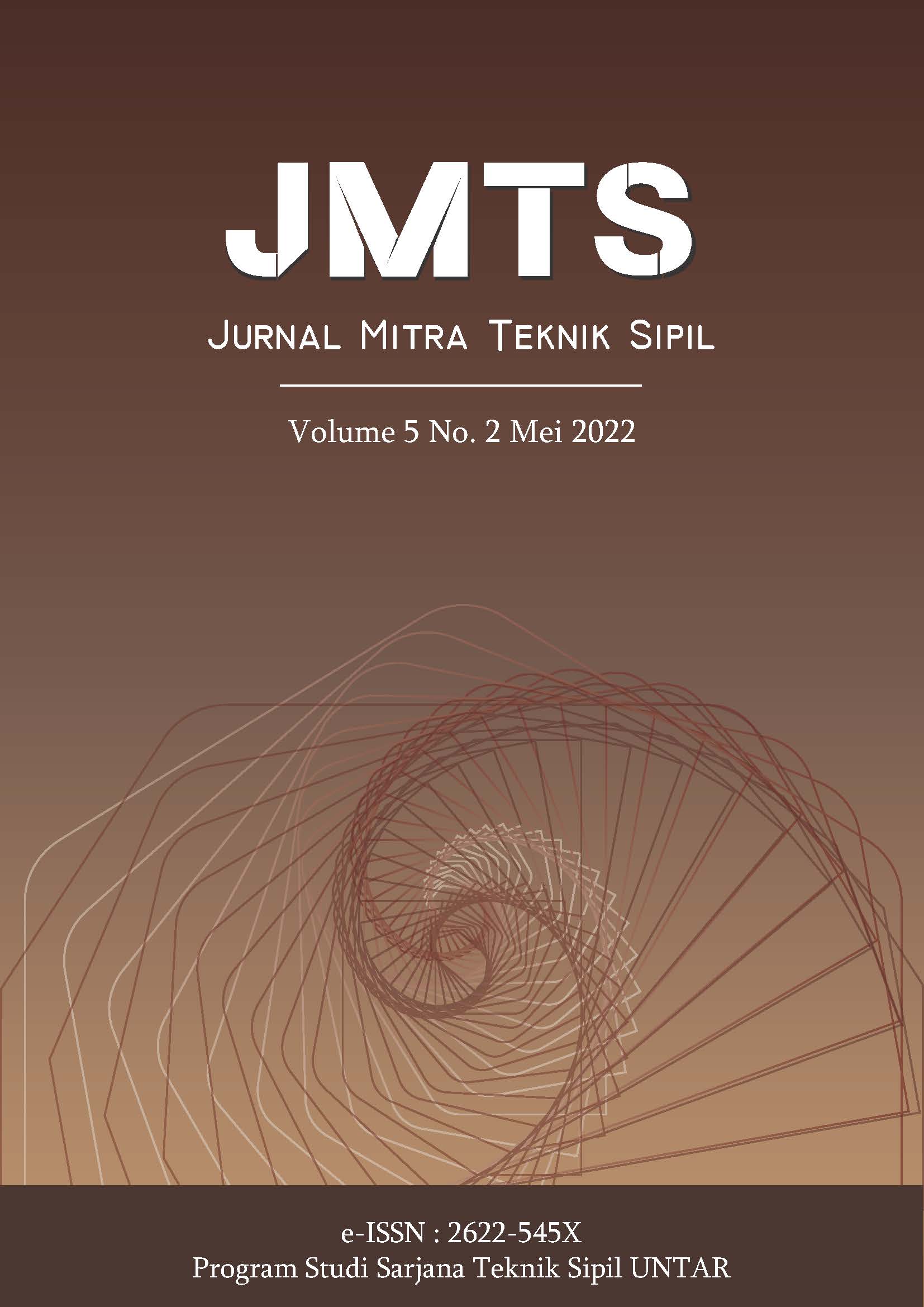ANALISIS RIWAYAT WAKTU FONDASI TIANG TUNGGAL DAN KELOMPOK DI TANAH LUNAK
Main Article Content
Abstract
Indonesian territory has high earthquake possibility because it lays on two seismic gaps. Earthquake can cause a great damage for mankind, in example deaths and infrastructure damage. Therefore, interventions are needed to prevent the damages by analyzing the effect of earthquake towards the foundation stability. The most common analysis method is time history analysis. Time history analysis is a step by step method to find out the respond that given by a structure by simulating an earthquake record to the structure model. This method needs a ground motion from an accelerogram. Spectral response is also needed from the area where the infrastructure will be built. This journal will analyze the time history on the single pile and group pile. This journal will used geotechnical-based programme which is Midas GTS NX that will resulting the displacement and the internal force caused by the seismic load. This journal is expected in assist the planning of a building by calculating the earthquake effects and minimalizing the possibility of pile foundation failure.
Wilayah Indonesia memiliki potensi gempa yang cukup besar karena dilewati oleh dua jalur seismik. Gempa bumi dapat mengakibatkan kerugian yang besar bagi umat manusia, seperti korban jiwa dan kerusakan infrastruktur. Maka dari itu, dibutuhkan langkah-langkah untuk mencegah hal tersebut dengan menganalisis efek gempa terhadap kestabilan fondasi. Salah satu analisis yang biasa digunakan adalah analisis riwayat waktu. Analisis riwayat waktu adalah suatu metode langkah demi langkah untuk mengetahui respons yang diberikan suatu struktur dengan cara pemberian rekaman gempa terhadap model struktur tersebut. Metode ini membutuhkan rekaman gerak tanah dari sebuah akselerogram. Diperlukan juga respon spektra dari daerah tempat dimana infrastruktur tersebut akan dibangun. Pada jurnal ini akan dilakukan analisis riwayat waktu pada tiang tunggal dan tiang kelompok. Jurnal ini menggunakan program Midas GTS NX yang berbasis geoteknik yang akan menghasilkan nilai perpindahan dan gaya dalam akibat beban gempa. Jurnal ini diharapkan dapat membantu dalam merencanakan sebuah bangunan dengan memperhitungkan pengaruh beban gempa dan meminimalisir kemungkinan terjadinya kegagalan fondasi tiang.
Article Details
References
Aswegan, K., & Charney, F. A. (2014). A Simple Linear Response History Analysis Procedure for Building Codes.
Proceedings of the 10th National Conference on Earthquake Engineering, 11.
Badan Standardisasi Nasional. (2019). Tata Cara Perencanaan Ketahanan Gempa Untuk Struktur Bangunan Gedung
dan Non Gedung SNI 1726:2019. Jakarta: BSN.
Badan Standardisasi Nasional. (2020). Tata Cara Pemilihan dan Modifikasi Gerak Tanah Permukaan Untuk
Perencanaan Gedung Tahan Gempa SNI 8899:2020. Jakarta: BSN.
Firmando, A., Wijaya, H., & Yuwono, A. (2021). Analisis Riwayat Waktu Gempa Sesar pada Sistem Fondasi Tiang.
Jurnal Mitra Teknik Sipil Volume 4, Nomor 1, 16.
Hardiyatmo, H. C. (2008). Teknik Fondasi II. Yogyakarta: Beta Offset.
Hsiung, B.-C. B., & Dao, S.-D. (2014). Evaluation of Constitutive Soil Models for Predicting Movements Caused by
a Deep Excavation in Sands. EJGE Vol. 19 [2014], Bund. Z5, 21.
Kevin, & Barus, S. (2014). Kajian Perbandingan Respon Dinamik Linier dengan Analisis Riwayat Waktu (Time
History Analysis) Menggunakan Modal Analisis (Mode Superposition Method) dan Integrasi Langsung (Direct Time
Integration Method). 15.
Lagaros, N., Papadrakakis, M., & Mitropoulou, C. C. (2013). Time History Seismic Analysis. 22.
Lumantarna, B. (1999). Gempa Rencana untuk Analisa Riwayat Waktu. DIMENSI TEKNIK SIPIL VOLUME 1, NO.
MARET 1999, 8.
Magar, J., Kudtarkar, A., Pachpohe, J., & Nagargoje, P. (2020). Study and Analysis of Types of Foundation and
Design Construction. International Research Journal of Engineering and Technology (IRJET) Volume: 07 Issue: 08
, 7.
Martini. (2009). ANALISIS DAYA DUKUNG TANAH PONDASI DANGKAL DENGAN BEBERAPA METODE.
Majalah Ilmiah Mektek Tahun XI No.2, 13.
Morris, G. J., Thompson, A. J., Dismuke, J. N., & Bradley, B. A. (2019). GROUND MOTION INPUT FOR
NONLINEAR RESPONSE HISTORY ANALYSIS: PRACTICAL LIMITATIONS OF NZS 1170.5 AND
COMPARISON TO US STANDARDS. Bulletin of the New Zealand Society for Earthquake Engineering, Vol. 52,No.
, September2019, 15.
Nedimovic, M. R. (2006). Crustal structure and seismic activity at subduction zones. 29.
Saini, S., & Goyal, E. T. (2019). ANALYSIS OF PILED RAFT FOUNDATION USING MIDAS GTS NX.
International Research Journal of Engineering and Technology (IRJET) Volume: 06 Issue: 05, 9.
Sardjono, I. H. (1988). Pondasi Tiang Pancang Jilid II. Surabaya: Sinar Wijaya.
Sekisov, A., Varvarkina, A., Gura, D., Savenko, A., & Shikhovtsov, A. (2019). PIT DESIGN TAKING INTO
ACCOUNT WATER LEVEL REDUCTION USING THE SOFTWARE PACKAGE MIDAS GTS NX. IIOAB
Journal Vol.10, 8.
Sumantri, A. (2020). Analisa Riwayat Waktu pada Struktur Bangunan dengan Menyertakan Efek Interaksi Tanah dan
Pondasi Tiang. Medan.
Tallapalem, U., Shaik, N., & Valluri, S. (2019). Time History Analysis on Precast Building . International Journal of
Recent Technology and Engineering (IRJTE) Volume-8 Issue-4, 8.
Ti, S. K., Huat, B. B., Noorzaei, J., Jaafar, M. S., & Sew, G. S. (2009). A Review of Basic Soil Constitutive Models
for Geotechnical Application. EJGE Vol. 14, Bund. J , 18.
Vakili, K. N., Lavasan, A. A., & Barciaga, T. (2013). A Practical Approach to Constitutive Models for the Analysis
of Geotechnical Problems. Institute for Foundation Engineering , Soil and Rock Mechanics, Ruhr-Universitat
Bochum, Germany, 13.
Wibowo, A. S. (2011). Analisis Kinerja Struktur pada Bangunan Tidak Beraturan dengan Analisis Dinamik
Menggunakan Metode Analisis Riwayat Waktu. 123.
Widojoko, L. (2015). Analisa Dan Desain Pondasi Tiang Pancang Berdasarkan Bentuk Tiang. Jurnal Teknik Sipil
UBL Volume 6 No. 2 Oktober 2015, 29.



